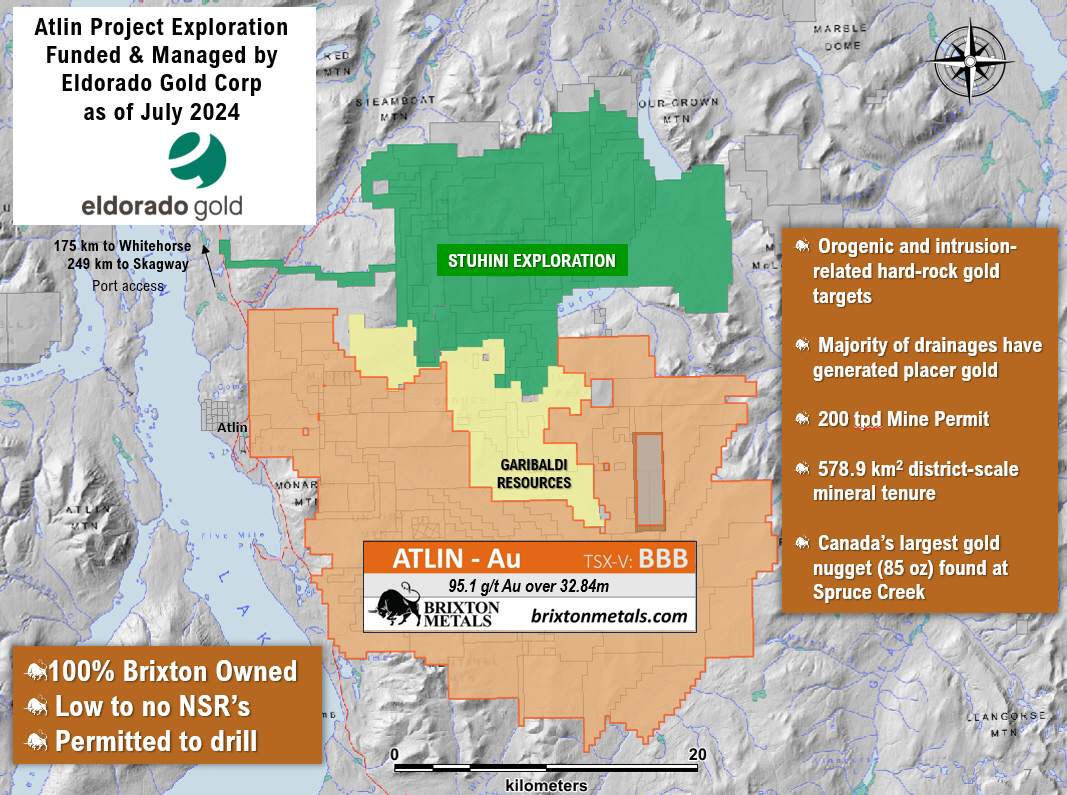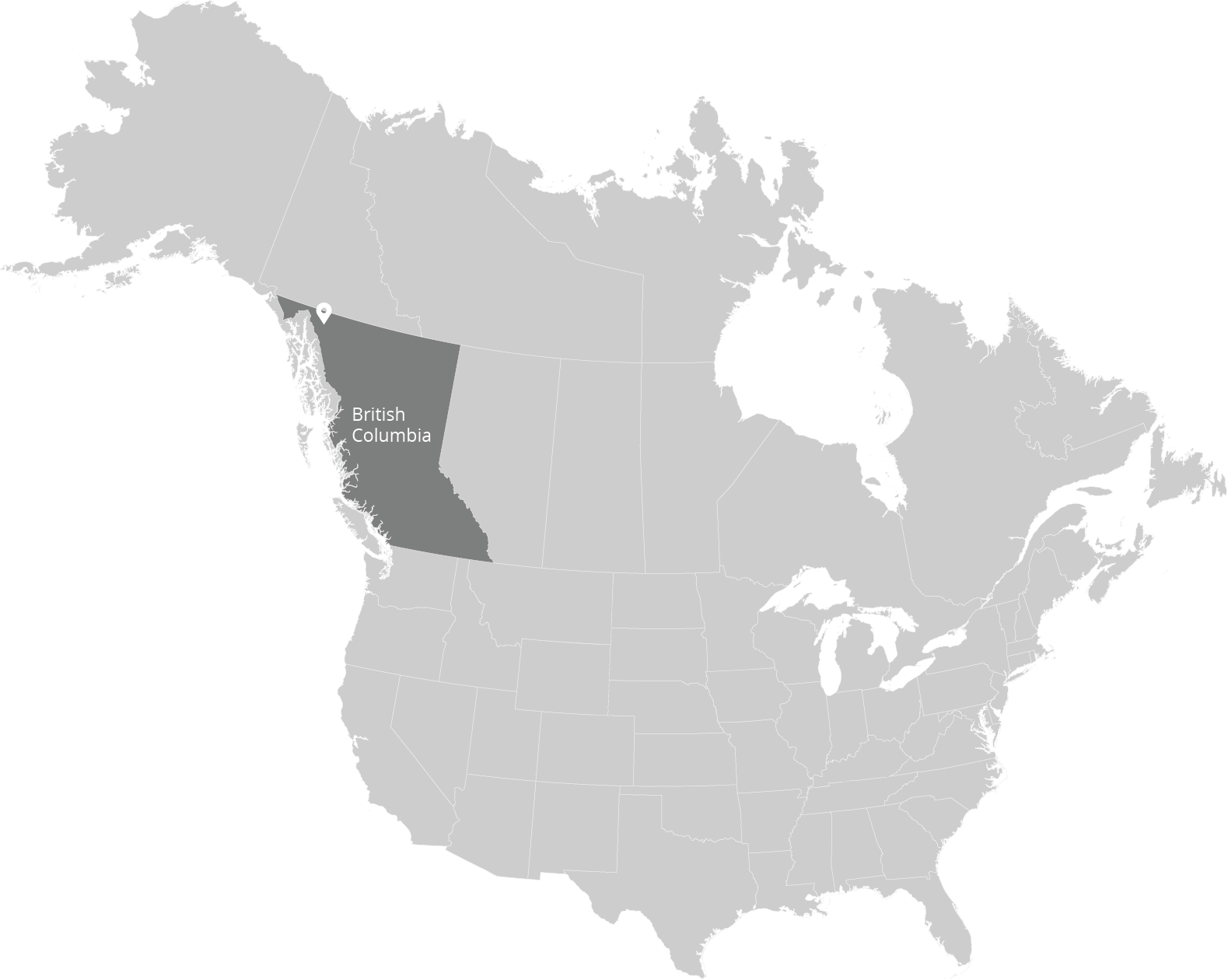This project is Optioned to Eldorado Gold Corporation (July 2024).
The Atlin gold camp is the second largest placer gold producer in British Columbia with a reported 600,000oz Au produced between 1898 and 1945, and an estimated additional 400,000oz Au produced since the record keeping ceased in 1946 (Ash 2001). The two major placer producing creeks are located on the Atlin Goldfields Project and exploration is focussed on finding the gold source.
Rock samples consisting of coarse-grained quartz veins hosted in listwanite have returned values of up to 293 g/t Au at the LD Showing (2017) and 53.6 g/t Au at the Union Mountain Showing (2020). Historical diamond drilling at the Yellowjacket target has returned up to 509.96 g/t Au (or 16.39 oz/ton Au) over 5.57 metres.
Location

History
Historic Inferred Resource Estimate completed in 2010: 133,000 tonnes @ 5.8 g/t Au, 24,000 oz Au
with a 1.5 g/t Au cut-off *
Total Drilling of 26,300 m distributed as follows:
149 DD holes totaling 19,365m
160 RC holes totaling 6,935m
36 Channels totaling 1,440m (40m/channel).
Gold recovery through simple gravity circuit (cyanide-free, no chemicals required).
*A QP for Brixton Metals has not done sufficient work to classify the historical estimate as a current mineral resource and the Company is not treating the historical estimate as a current mineral resource
Geology
The Atlin Goldfields property is underlain primarily by Mississippian to Triassic-aged volcanic and sedimentary rocks of the Cache Creek Complex, including quartz-carbonate-mariposite-altered ultramafic and mafic rocks (‘listwanite’), which are commonly associated with the gold mineralization in the region. The Cache Creek Complex is intruded by the Middle Jurassic Fourth of July batholith and the Late Cretaceous Surprise Lake batholith.
Mineralization
Placer mining from the Atlin creeks produces mostly sharp-edge, “hackly” gold nuggets, indicating proximity to a mineralized source. Gold mineralization at the Yellowjacket, LD, Union and Pictou showings are hosted within quartz-carbonate veins, located within or near-to major faults. Altered mafic and ultramafic rocks of the Cache Creek Complex are typically the host to the gold-bearing veins but they have also been observed within sedimentary rocks, specifically graphitic and quartz-rich phyllitic bedrock (Mihalynuk et al. 2017).
Detailed geochemical research conducted on select Atlin gold nuggets has revealed the presence of tin (cassiterite) and thorium (thorite) mineral intergrowths. These intergrowths are rich in Sn, Th, U, Mo, W, and F, indicating a potential association with the Sn-U-Th-Mo-W-F rich Surprise Lake batholith (Mihalynuk et al. 2017).
The findings suggest the presence of both orogenic gold and intrusion-related gold systems on the Atlin property. This implies that there are multiple sources of gold mineralization, increasing the potential for diverse and valuable gold deposits within the area.
The Atlin gold camp is the second largest gold producer in British Columbia (Ash 2001) with reported placer gold production of over 600,000 oz Au between 1898 and 1945 from creeks in the area.
Atlin continues to produce gold to this day, although yields have not been reported since 1946. The area was discovered in 1896 and has produced gold for 125 years. The Atlin Goldfields Camp holds the provincial record for the largest gold nugget, which weighed 2.6 kg or 85 oz, and was discovered on Spruce Creek (BCGS Paper 2017-1, p.179-193).
While significant tonnage has been recovered historically from placer mining, very limited exploration work in the camp has been conducted on discovering the hard rock source of the Atlin gold. Brixton’s claims are strategically located in this highly prospective mining camp, covering 579 km2.
The Atlin Goldfields Project is located within the Taku River Tlingit First Nation traditional territory. Brixton’s wholly owned Atlin Goldfields Project covers approximately 579 square kilometers of favourable and structurally intricate geology within the Atlin Mining District of NW, BC. The property is road accessible, located just 9 kilometers east of the community of Atlin, BC.

Atlin Project